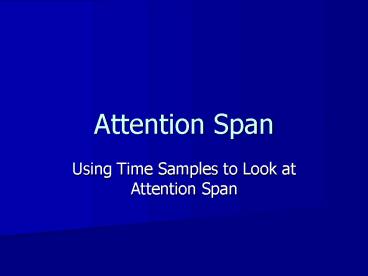Attention Span - PowerPoint PPT Presentation
1 / 23
Title:
Attention Span
Description:
Played with Fatima on the climber for 5 minutes. Then moved with Fatima to the blocks, where they played for 15 minutes. ... Fatima left blocks to go to the sand table ... – PowerPoint PPT presentation
Number of Views:2673
Avg rating:3.0/5.0
Title: Attention Span
1
Attention Span
- Using Time Samples to Look at Attention Span
2
How do you use your time?
- Think of a time of the week when you have a
choice of activities. What would you like to do? - Jot it down
3
Choice of activities is governed by some
assumptions
- You are more likely to do what you like to do
rather than what you have to do. - You do what you have the opportunity to do.
- If your first choice isnt available, you may
choose a related activity. - You are more likely to do it if you feel you will
be successful
4
- You may choose an activity because your friends
are doing it. - While you are doing something you like, time
passes quickly total absorption filters out
intrusions.
5
What does this have to do with observing young
children?
- By observing childrens choice of activities, we
gather much information about them. We discover
6
- Choice of activities reveals interests
- Avoidance of activities may reveal lack of
interest OR lack of competence. - A child may look for related activities when
their first choice is not available. - Children will choose and give attention to
activities where they find success
7
- Children are sometimes influenced by friends
choices - Children involved in an activity may be reluctant
to bring it to a close.
8
A time sample traces childrens choices,
playmates and the time they spend in one area.
It is
- Suitable for children ages 3 and older
- Only useful when the child has a choice of
activities.
9
Open your book and look at the time sample
illustrated in figure 7.2.
- Note that it covers 30 minutes at 5 minute
intervals. - Children have all arrived and are actively
engaged - Learning centers are listed down the left margin.
10
- The recorder looks at each area and writes down
the names of children who are in that area at the
moment of recording - Look at the key at the bottom.
- Follow Jenny, Amy and Edward.
- What did you learn about them?
11
Amy
- Spent 10 minutes each doing puzzles, making a
collage, and at the sand table. - Doesnt appear to have been playing with anyone
else. - May have made her choices based on what looked
interesting to her.
12
Jenny
- Had some difficulty in the puzzle area
- Moved to the sand table and had difficulty there
- Played with other children at the art table and
on the climber - Spent only 5 minutes in each area until she went
to the book area, where there was an adult.
Spent 10 minutes (or more) there.
13
Edward
- Played with Fatima on the climber for 5 minutes
- Then moved with Fatima to the blocks, where they
played for 15 minutes. - They incorporated Galina into their play
- Fatima left blocks to go to the sand table
- Then Edward left blocks and also went to the sand
table where he played with Fatima again.
14
Questions raised
- Is Edward making choices based on his interests
in the areas or in playing with Fatima? - Does Jenny need a quiet place in order to
concentrate for more than 5 minutes? - Does Jenny do best in an area where there are
fewer children? Or where there is an adult?
15
We cannot draw conclusions based on one
recording. We must compare recording done on
several occasions.
16
A time sample
- Is a CLOSED method of recording
- Records only what the child is doing at the
moment - Does not detail what they are doing, how they
are doing it or what they are saying. - Gives quantitative (numerical) information
- Gives clues inferred by choices
- Can be the basis for further specific observation
17
One of the fundamental requirements for learning
is a focused attention span. People who cannot
focus have difficulty learning.
18
Take the quiz in figure 7.3 How do you learn?
19
Learning is highly complex and individually
different.
- The art of teaching does not begin with knowing
the pupil, but with knowing oneself. Recognizing
that others learn in ways different from
ourselves profoundly affects our understanding
and teaching.
20
If you are a teacher currently working in a
classroom, look around your room, and at the
children who have difficulty making choices. Are
there lots of varied opportunities for children
with many different learning styles? The child
who has difficulty making choices may need
different opportunities or environmental changes.
21
Association/disequilibrium/assimilationReview
figure 7.9
- The child is involved in active exploration to
form his/her own knowledge. - Knowledge is not the transfer of abstract
information but the formation of associated
knowledge based on past knowledge or information.
22
- Each new piece of information goes through this
cycle, trying to make a match - Piaget calls this constructing knowledge
23
(No Transcript)






























![Download Book [PDF] Your In-Flight Entertainment PowerPoint PPT Presentation](https://s3.amazonaws.com/images.powershow.com/10064908.th0.jpg?_=20240626106)
